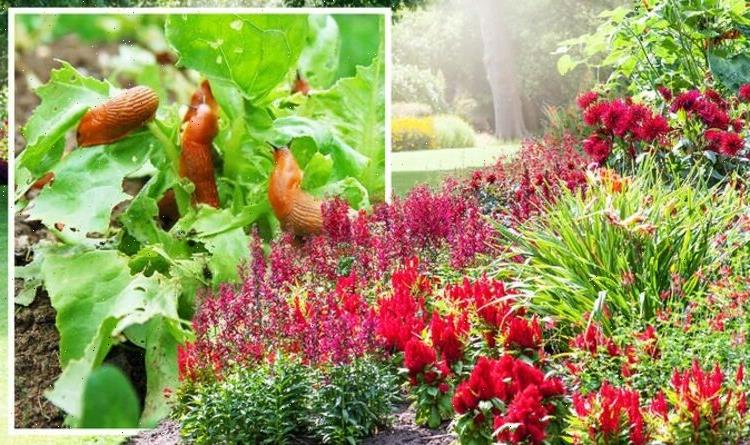Monty Don shares ways to stop slugs eating young plants
We use your sign-up to provide content in ways you’ve consented to and to improve our understanding of you. This may include adverts from us and 3rd parties based on our understanding. You can unsubscribe at any time. More info
Plants are able to tolerate a few pests, but they can quickly suffer when too many gather in the garden. As new growth begins to emerge through spring, a host of new pests will be enticed by fresh crops and bright blooms, but which species are you most likely to see? These are the five most common pests to watch out for this spring.
Keeping your garden clean and free of debris is one way to deter plant-loving bugs and insects, but some species will still manage to get into your plants and fruitful crops.
The warmer spring weather can attract everything from slugs to larvae to garden plants, and there are a number of key signs which could indicate their presence.
Leaf miners
“Leaf miners” describes the larvae of various pests, such as moths, flies and beetles.
Although the larvae create trails and blotchy areas as they feed on the leaves, they are actually relatively harmless and require no treatment.
However, a severe infestation can be managed with sticky traps and insecticidal soap to trap egg-laying adults.


Slugs
These slow-moving pests can quickly duplicate in the warm, moist spring climate, and are especially prominent in gardens full of young seedlings.
Slugs will hide in cool, damp places during the day and emerge on warm evenings to feed on green leaves.
Mulching around plants may increase slug problems, but it can be easily managed by:
- Reducing your watering schedule for problem-plants
- Use cardboard and newspaper to separate the soil between rows in vegetable patches
- Lift shelter materials
- Harvest slugs by scraping them into a container of soapy water

Thrips
Adult thrips are a dormant threat to your garden throughout the winter when they settle into bark, plant debris and other materials.
Once these mature pests are done overwintering, they become active in early spring (late March), when they begin to lay eggs in plant tissues.
The sap-sucking insects discolour and distort nearly any type of plant, often leaving tiny black specks of excrement on the leaves and white patches on petals.
Eggs can hatch in as little as three to five days, when hungry nymphs emerge ready to feed for around one to three weeks.
According to the Almanac, thrips can have up to 15 generations per year outdoors, though neem oil soap and sticky traps work well to control infestations.
DON’T MISS:
Gardening hacks: How to get rid of slugs and snails with popular drink [INSIGHT]
‘Fantastic way’ to protect plants from slug infestations [REVEAL]
David Domoney recommends trick to kill weeds that doesn’t cost a penny [ANALYSIS]

Glasshouse whitefly
Whiteflies are sap-sucking bugs which feed on many vegetables and ornamental plants grown in greenhouses.
It is relatively easy to spot whiteflies on infested plants, creating a cloud of small white-winged insects (1.5mm long) above the host plant.
You may also see flat, oval, creamy white scale-like nymphs on the underside of leaves, or sooty mould growth on the foliage, stems and fruits of your plants.
According to the Royal Horticultural Society (RHS), these destructive pests are known to target:
- Cucumber
- Melon
- Tomato
- Peppers
- Chrysanthum
- Genera
- Pelargonium
- Fuchsia
- Lantana
- Poinsettia
- Verbena
While these pests are active all year round, spring is a crucial time to begin checking your plants before a damaging population has developed.
Earwigs
These omnivorous pests feed on other small invertebrates and plant material, particularly on the flowers of clematis, dahlias and chrysanthemums.
Surprisingly, earwigs can be beneficial for the growth of fruit trees as they are useful predators of fruit aphids.
According to the RHS, the most common symptoms of earwigs in your spring garden include:
- Nibbled petals and young leaves on flowers
- Tattered, vein-like foliage structures on older growth
- Earwigs feeding on plants at night – these pests are nocturnal so it’s best to check plants after dark using a torch
One of the easiest ways to trap earwigs is to place upturned flower pots filled with hay or straw on canes among vulnerable plants.
Each morning, shake out the pots and remove these nuisance pests in order to monitor their numbers.
Source: Read Full Article
